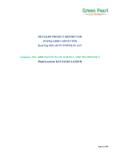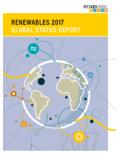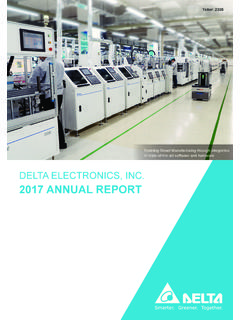Transcription of Grid Integration of Aggregated Demand Response, Part 2 ...
1 NREL is a national laboratory of the Department of Energy Office of Energy Efficiency & Renewable Energy Operated by the Alliance for Sustainable Energy, LLC This report is available at no cost from the National Renewable Energy Laboratory (NREL) at Contract No. DE-AC36-08GO28308 grid Integration of Aggregated Demand Response, Part 2: Modeling Demand Response in a Production Cost Model Marissa Hummon, David Palchak, Paul Denholm, and Jennie Jorgenson National Renewable Energy Laboratory Daniel J. Olsen, Sila Kiliccote, Nance Matson, Michael Sohn, Cody Rose, Junqiao Dudley, and Sasank Goli Lawrence Berkeley National Laboratory Ookie Ma Department of Energy Technical report NREL/TP-6A20-58492 December 2013 NREL is a national laboratory of the Department of Energy Office of Energy Efficiency & Renewable Energy Operated by the Alliance for Sustainable Energy, LLC This report is available at no cost from the National Renewable Energy Laboratory (NREL) at Contract No.
2 DE-AC36-08GO28308 National Renewable Energy Laboratory 15013 Denver West Parkway Golden, CO 80401 303-275-3000 grid Integration of Aggregated Demand Response, Part 2: Modeling Demand Response in a Production Cost Model Marissa Hummon, David Palchak, Paul Denholm, and Jennie Jorgenson National Renewable Energy Laboratory Daniel J. Olsen, Sila Kiliccote, Nance Matson, Michael Sohn, Cody Rose, Junqiao Dudley, and Sasank Goli Lawrence Berkeley National Laboratory Ookie Ma Department of Energy Prepared under Task No. Technical report NREL/TP-6A20-58492 December 2013 NOTICE This report was prepared as an account of work sponsored by an agency of the United States government.
3 Neither the United States government nor any agency thereof, nor any of their employees, makes any warranty, express or implied, or assumes any legal liability or responsibility for the accuracy, completeness, or usefulness of any information, apparatus, product, or process disclosed, or represents that its use would not infringe privately owned rights. Reference herein to any specific commercial product, process, or service by trade name, trademark, manufacturer, or otherwise does not necessarily constitute or imply its endorsement, recommendation, or favoring by the United States government or any agency thereof.
4 The views and opinions of authors expressed herein do not necessarily state or reflect those of the United States government or any agency thereof. This report is available at no cost from the National Renewable Energy Laboratory (NREL) at Available electronically at Available for a processing fee to Department of Energy and its contractors, in paper, from: Department of Energy Office of Scientific and Technical Information Box 62 Oak Ridge, TN 37831-0062 phone: fax: email: Available for sale to the public, in paper, from: Department of Commerce National Technical Information Service 5285 Port Royal Road Springfield, VA 22161 phone: fax: email.
5 Online ordering: Cover Photos: (left to right) photo by Pat Corkery, NREL 16416, photo from SunEdison, NREL 17423, photo by Pat Corkery, NREL 16560, photo by Dennis Schroeder, NREL 17613, photo by Dean Armstrong, NREL 17436, photo by Pat Corkery, NREL 17721. Printed on paper containing at least 50% wastepaper, including 10% post consumer waste. iii Foreword This report is one of a series stemming from the Department of Energy (DOE) Demand Response and Energy Storage Integration Study. This study is a multi-national-laboratory effort to assess the potential value of Demand response (DR) and energy storage to electricity systems with different penetration levels of variable renewable resources and to improve our understanding of associated markets and institutions.
6 This study was originated, sponsored, and managed jointly by the Office of Energy Efficiency and Renewable Energy and the Office of Electricity Delivery and Energy Reliability. grid modernization and technological advances are enabling resources, such as DR and energy storage, to support a wider array of electric power system operations. Historically, thermal generators and hydropower in combination with transmission and distribution assets have been adequate to serve customer loads reliably and with sufficient power quality, even as variable renewable generation like wind and solar power become a larger part of the national energy supply.
7 While DR and energy storage can serve as alternatives or complements to traditional power system assets in some applications, their values are not entirely clear. This study seeks to address the extent to which DR and energy storage can provide cost-effective benefits to the grid and to highlight institutions and market rules that facilitate their use. The project was initiated and informed by the results of two DOE workshops; one on energy storage and the other on DR. The workshops were attended by members of the electric power industry, researchers, and policymakers, and the study design and goals reflect their contributions to the collective thinking of the project team.
8 Additional information and the full series of reports can be found at This report is available at no cost from the National Renewable Energy Laboratory (NREL) at Acknowledgments The authors would like to thank the following individuals for their valuable input and comments during the analysis and publication process: Mark O Malley, Brendan Kirby, Elaine Hale, Trieu Mai, Nate Blair, Keith Searight, Erik Ela, Chunlian Jin, Di Wu, and Michael Kintner-Meyer. Any errors or omissions are solely the responsibility of the authors. This report is available at no cost from the National Renewable Energy Laboratory (NREL) at Executive Summary Introduction Renewable Integration studies have evaluated many challenges associated with deploying large amounts of variable wind and solar generation technologies.
9 These studies can evaluate operational impacts associated with variable generation, benefits of improved wind and solar resource forecasting, and trade-offs between institutional changes, including increasing balancing area cooperation and technical changes such as installing new flexible generation. Demand response (DR) resources present a potentially important source of grid flexibility and can aid in integrating variable generation; however, Integration analyses have not yet incorporated these resources explicitly into grid simulation models as part of a standard toolkit for resource planners.
10 Part 1 of this report , Load Availability Profiles and Constraints for the Western Interconnection, examines the potential for different types of commercial and residential building, municipal, and industrial non-manufacturing loads to provide bulk power system services [1]. Industrial manufacturing loads were examined and quantified by Starke et al. [2]. These include energy, capacity, and operating reserves. Their abilities to provide energy and operating reserve services are represented by a set of hourly availabilities for each service, including some additional resource constraints specific to individual end-use types.














